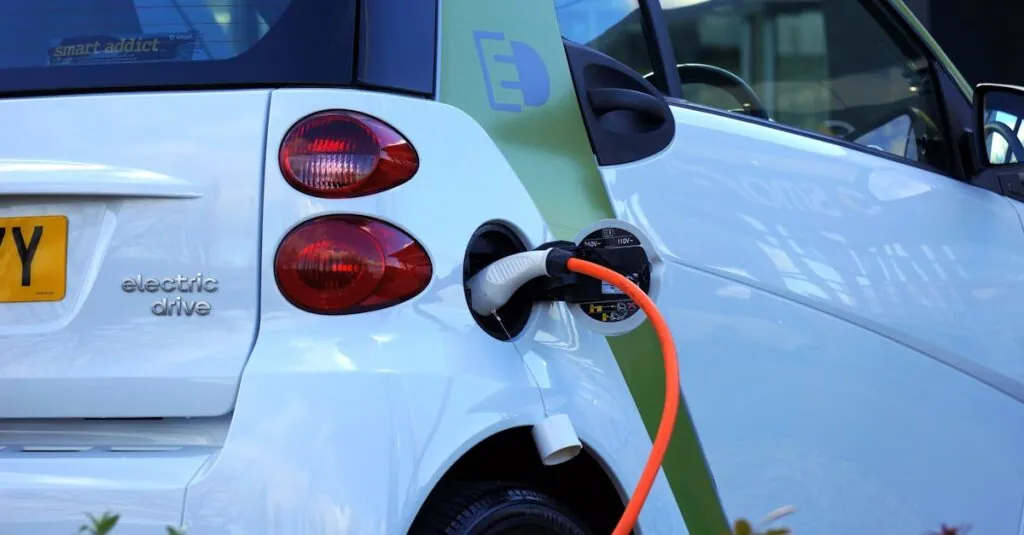Electric vehicles are zooming into the spotlight, and it’s not just because they’re silent as a ninja in a library. With the world buzzing about climate change and fossil fuels, these eco-friendly rides are stealing hearts and headlines. Imagine gliding down the road with zero emissions, feeling like a superhero while saving the planet—who wouldn’t want that?
Table of Contents
ToggleOverview Of Electric Vehicles
Electric vehicles (EVs) run on electricity instead of traditional fossil fuels. They utilize rechargeable batteries, which store energy from various sources, including renewable energy. The market for EVs has significantly expanded, with global sales reaching approximately 6.6 million units in 2021, marking a 108% increase from the previous year.
Different types of electric vehicles exist, including battery electric vehicles (BEVs), plug-in hybrid electric vehicles (PHEVs), and fuel cell electric vehicles (FCEVs). BEVs operate solely on electric power, while PHEVs can switch between electric and gas power. FCEVs generate electricity through a chemical reaction in fuel cells.
EVs offer numerous advantages over conventional vehicles. They reduce greenhouse gas emissions, leading to improved air quality. Many EVs qualify for government incentives, such as tax credits or rebates, resulting in lower overall costs for consumers.
Charging infrastructure continues to grow, making EV ownership more convenient. Public charging stations are increasingly available, and home charging options allow for easy overnight refueling. Fast charging technologies can recharge batteries up to 80% in about 30 minutes.
Automakers are investing heavily in EV technology. Major companies like Tesla, Nissan, and Volkswagen are developing innovative EV models. The transition towards electric mobility presents an opportunity for sustainable transportation solutions.
Consumer interest in EVs continues to rise as awareness of environmental issues grows. This shift reflects a demand for cleaner, greener alternatives to fossil fuel vehicles. Electric vehicles represent a key component in the effort to combat climate change while promoting energy independence.
Types Of Electric Vehicles
Electric vehicles come in various types, each offering distinct features and benefits. Understanding these types aids consumers in making informed decisions.
Battery Electric Vehicles (BEVs)
Battery electric vehicles operate solely on electric power, utilizing rechargeable batteries to store energy. With zero tailpipe emissions, they contribute significantly to reducing greenhouse gases. Popular models include the Tesla Model 3 and Nissan Leaf, showcasing advancements in range and performance. Charging these vehicles occurs at home or at public charging stations, supporting convenience. BEVs offer a quiet driving experience and attempt to eliminate reliance on fossil fuels, aligning with sustainable practices.
Plug-In Hybrid Electric Vehicles (PHEVs)
Plug-in hybrid electric vehicles combine traditional combustion engines with electric propulsion. Owners can charge PHEVs at home or use gasoline for long trips, offering flexibility. Models like the Toyota Prius Prime and Ford Escape Hybrid provide an optimal balance between electric range and gasoline efficiency. These vehicles emit fewer emissions than conventional vehicles and often allow for short commutes powered solely by electricity. PHEVs support eco-friendly driving habits while ensuring practicality in various driving conditions.
Fuel Cell Electric Vehicles (FCEVs)
Fuel cell electric vehicles generate electricity through a chemical reaction between hydrogen and oxygen, producing only water as a byproduct. This technology represents a clean energy source, with models like the Toyota Mirai highlighting its potential. FCEVs typically require hydrogen fueling stations, which are less widespread than electric charging stations. Drivers of FCEVs enjoy quick hydrogen refueling times comparable to gasoline vehicles. As the hydrogen infrastructure expands, these vehicles may significantly contribute to sustainable transportation solutions.
Benefits Of Electric Vehicles
Electric vehicles offer a range of advantages that contribute to both environmental sustainability and economic savings. Their benefits strengthen the case for choosing EVs over conventional vehicles.
Environmental Impact
Electric vehicles significantly reduce greenhouse gas emissions. Transitioning to EVs can cut lifetime emissions by 50% compared to gasoline-powered cars, particularly when charged with renewable energy. Improved air quality accompanies this reduction, leading to healthier communities. Furthermore, many EVs use recyclable materials in their construction, minimizing waste in landfills. Overall, the environmental benefits demonstrate a powerful commitment to combating climate change.
Economic Advantages
Economic savings create an appealing aspect of electric vehicles. Operating costs for EVs can be as much as 60% lower than those for traditional vehicles due to reduced fuel and maintenance expenses. Government incentives provide further financial relief, with federal tax credits reaching up to $7,500. Many states also offer additional rebates, further driving down the initial purchase price. Resale values for certain models remain strong, ensuring a profitable eventual return on investment.
Technological Innovations
Technological innovations enhance the appeal of electric vehicles. Advanced battery technology continues to improve driving ranges, with many models offering over 300 miles per charge. Rapid charging stations are proliferating, allowing quicker recharge times—some achieving an 80% charge in under 30 minutes. Moreover, emerging features such as autonomous driving and smart connectivity add to the driving experience. Manufacturers are consistently focused on refining these technologies to support consumer demands for enhanced performance and convenience.
Challenges Facing Electric Vehicles
Electric vehicles face several challenges as their popularity grows. These obstacles can affect their widespread adoption and market success.
Charging Infrastructure
Limited charging stations hinder the convenience of owning electric vehicles. Although many public charging options exist, they may not meet the demand during peak travel times. Many regions lack sufficient charging networks to support long-distance travel, leading to range anxiety among potential EV owners. Significant investments in charging infrastructure are essential to expand availability and improve user experience. Initiatives to create faster charging solutions also contribute to reducing wait times for drivers, making EV ownership more appealing.
Battery Technology
Battery technology continues to be a crucial bottleneck for electric vehicles. Current lithium-ion batteries have limitations regarding range, recharge time, and overall lifecycle. Innovations in solid-state batteries promise improved energy density and safety, but widespread adoption remains years away. Recycling old batteries presents additional challenges, requiring sustainable methods to minimize environmental impact. Ongoing research aims to enhance battery performance and reduce costs, driving advancements in the EV market.
Cost Considerations
Initial costs for electric vehicles can deter some buyers, despite lower operating expenses. Many consumers find EVs more expensive than traditional vehicles, even with government incentives. As production scales and technology advances, costs are likely to decline. The total cost of ownership may favor electric vehicles, with savings on fuel and maintenance over time. Understanding both the upfront investment and long-term savings helps consumers make informed purchasing decisions.
Future Of Electric Vehicles
Electric vehicles continue to evolve, signaling a strong shift towards sustainable transportation. Innovations in battery technology promise to increase range and decrease charging times. For example, solid-state batteries, which are in development, could enhance safety and efficiency while addressing current limitations.
Charging infrastructure expands rapidly, making it more convenient for EV owners. Major cities are increasing the number of public charging stations, ensuring accessibility for drivers. Home charging options also improve, with many neighborhoods implementing more residential charging systems.
Automakers are pivoting to electric vehicle production, with traditional manufacturers investing heavily in new EV models. Tesla, Nissan, and Volkswagen lead the way, developing advanced technology that enhances performance and features. Popular models like the Tesla Model Y and Ford Mustang Mach-E showcase innovation and consumer appeal.
Government policies also play a pivotal role in the future of electric vehicles. Incentives to reduce purchase costs and manufacturing subsidies encourage manufacturers to explore more sustainable options. As environmental regulations tighten, automakers adjust strategies to align with government mandates.
Consumer demand trends toward eco-friendly automobiles suggest a positive outlook for electric vehicles. Increased awareness about climate change drives interest and fosters a shift from conventional vehicles. Efforts to improve battery disposal and recycling practices will address environmental concerns associated with production waste.
Advancements in autonomous driving technology further integrate with electric vehicles to enhance safety and efficiency. Manufacturers are exploring the potential of self-driving EVs that improve urban mobility while minimizing congestion and pollution. As these developments progress, electric vehicles will play a vital role in future transportation networks.
Electric vehicles are more than just a trend; they represent a significant shift toward sustainable transportation. As awareness of environmental issues grows, consumers are increasingly drawn to the benefits of EVs, from reduced emissions to lower operating costs.
The ongoing advancements in technology and the expansion of charging infrastructure are making electric vehicles more accessible and appealing. With major automakers investing heavily in this sector, the future of transportation looks promising.
Government support further enhances this momentum, paving the way for a cleaner and more efficient automotive landscape. As electric vehicles continue to evolve, they’ll play a crucial role in shaping a sustainable future for generations to come.






